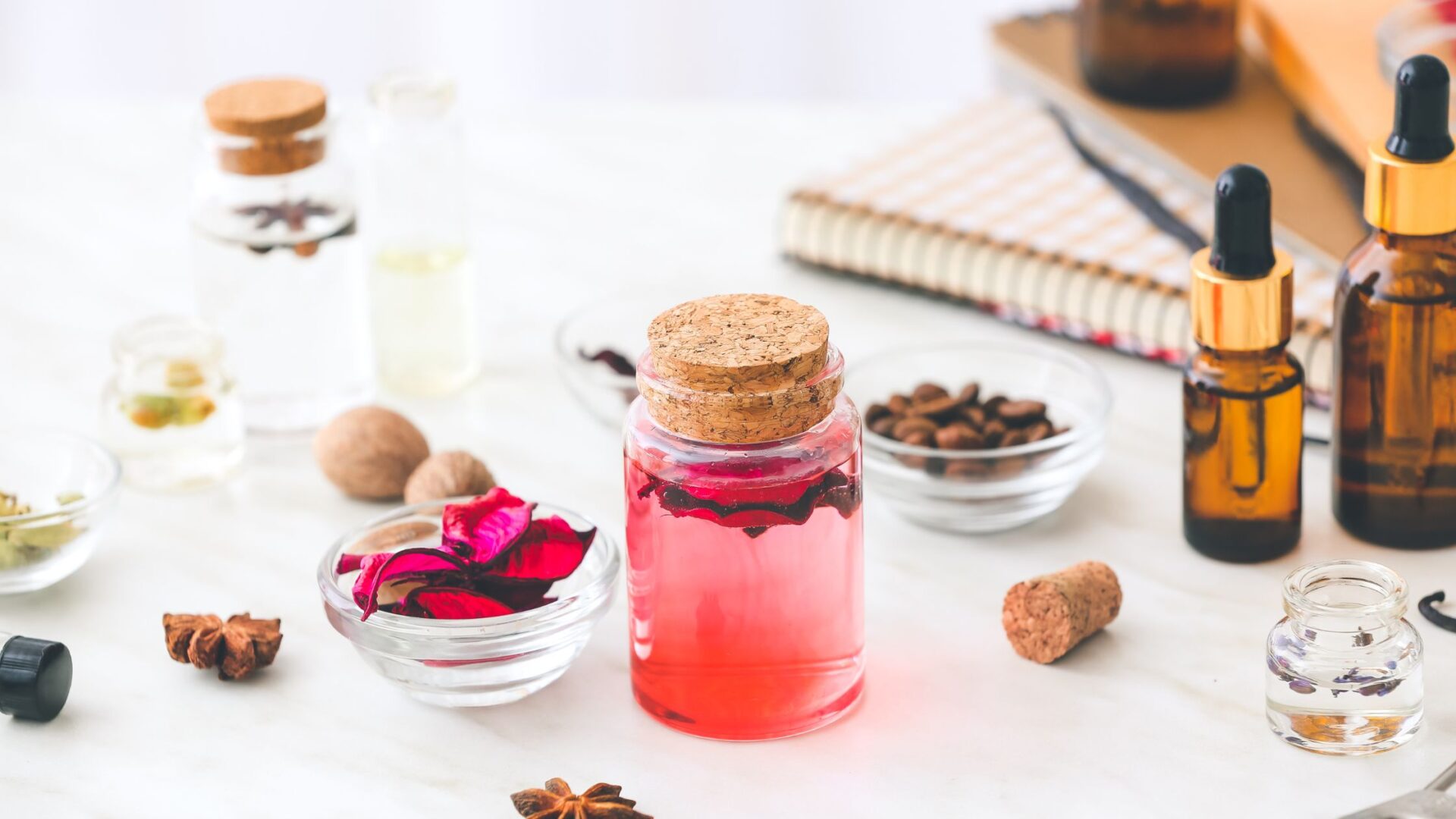Have you ever wanted to make your own perfume at home, but thought it was too complicated or expensive? Well, think again. You can create your own fragrance at home with simple ingredients that you can find in your kitchen, garden, or local store. In this blog post, I will show you how to make perfume easily at home with some basic steps and tips. You will learn:
- How to choose the right ingredients for your perfume
- How to extract the scent from the ingredients
- How to blend the scents together
- How to store and use your perfume
Making your own perfume is not only fun and creative, but also has many benefits. You can save money, avoid harmful chemicals, customize your fragrance, and enjoy the therapeutic effects of aromatherapy. So, what are you waiting for? Let’s get started!
Choosing the Right Ingredients for Your Perfume
The first step to making your own perfume is choosing the right ingredients. You will need two types of ingredients: essential oils and carrier oils.
Essential Oils
Essential oils are the oils that will give your perfume its fragrance. They are extracted from various parts of plants, such as flowers, leaves, fruits, roots, and barks. They have different aromas and properties that can affect your mood and well-being.
There are hundreds of essential oils available in the market, but you don’t need to buy them all. You can start with a few basic ones that are versatile and easy to find. Some examples are:
- Lavender: A floral and soothing scent that can help you relax and sleep better.
- Rose: A sweet and romantic scent that can uplift your mood and enhance your love life.
- Lemon: A citrus and refreshing scent that can energize you and boost your immunity.
- Peppermint: A minty and cooling scent that can relieve headaches and nausea.
- Sandalwood: A woody and exotic scent that can calm your nerves and increase your focus.
You can also experiment with other essential oils that suit your preferences or desired effects. For example, if you want a spicy and warm scent, you can try cinnamon, clove, or ginger. If you want a fruity and cheerful scent, you can try orange, grapefruit, or mango.
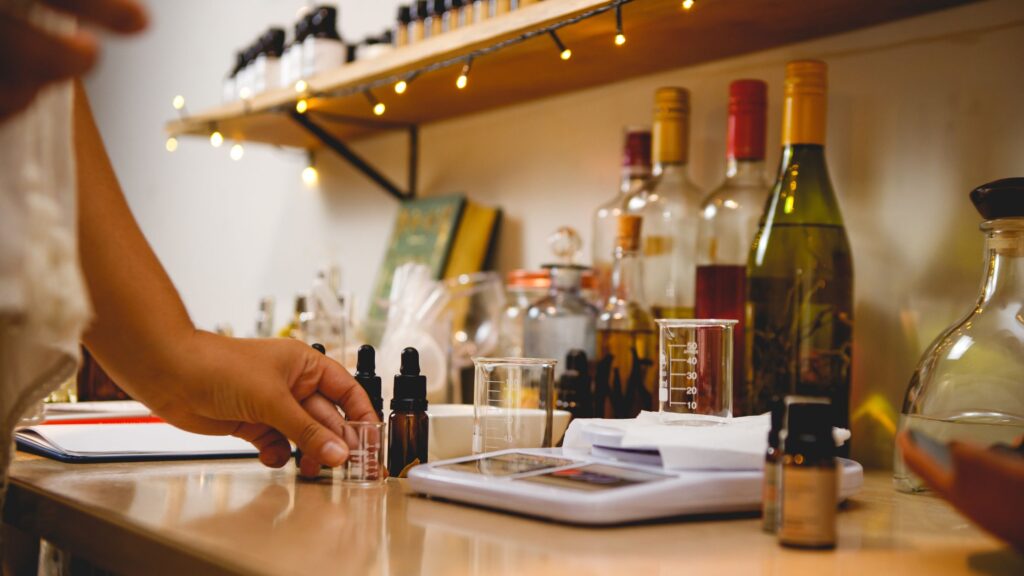
Carrier Oils
Carrier oils are the oils that will help to dilute the essential oils and make them easier to apply to the skin. They are usually derived from nuts, seeds, or fruits. They have little or no scent of their own, so they won’t interfere with the fragrance of your perfume.
Some examples of carrier oils are:
- Jojoba oil: A light and moisturizing oil that is suitable for all skin types. It is also similar to the natural oil of your skin, so it won’t clog your pores or cause irritation.
- Almond oil: A rich and nourishing oil that is good for dry or sensitive skin. It also has anti-inflammatory and anti-aging properties.
- Coconut oil: A solid oil that melts at room temperature. It has a mild coconut scent that can add a tropical touch to your perfume. It also has antibacterial and antifungal properties.
- Olive oil: A common oil that you can find in your kitchen. It has a strong olive scent that may not be ideal for some people, but it is very hydrating and soothing for the skin.
Extracting the Scent from the Ingredients
The next step to making your own perfume is extracting the scent from the ingredients. There are different methods to do this, but one of the easiest and most popular ones is called enfleurage.
Enfleurage is a process of infusing carrier oil with fresh flowers or herbs. It is simple and inexpensive, but it takes time and patience. Here’s how to do it:
- Choose fresh flowers or herbs that have a strong scent, such as lavender, rose, jasmine, mint, or basil.
- Pick them in the morning when they are most fragrant.
- Rinse them gently with water and pat them dry with a paper towel.
- Fill a glass jar with carrier oil of your choice.
- Add the flowers or herbs to the jar until they are completely submerged in the oil.
- Close the lid and shake the jar gently to mix the oil and the ingredients.
- Place the jar in a sunny spot, such as a windowsill or a balcony.
- Let the jar sit for at least two weeks, shaking it once a day.
- After two weeks, strain the oil through a cheesecloth or a coffee filter into another jar.
- Discard the flowers or herbs and repeat the process with fresh ones until you get the desired scent.
You can also use other methods to extract the scent from the ingredients, such as distillation, maceration, or solvent extraction. However, these methods are more complicated and require special equipment and skills.
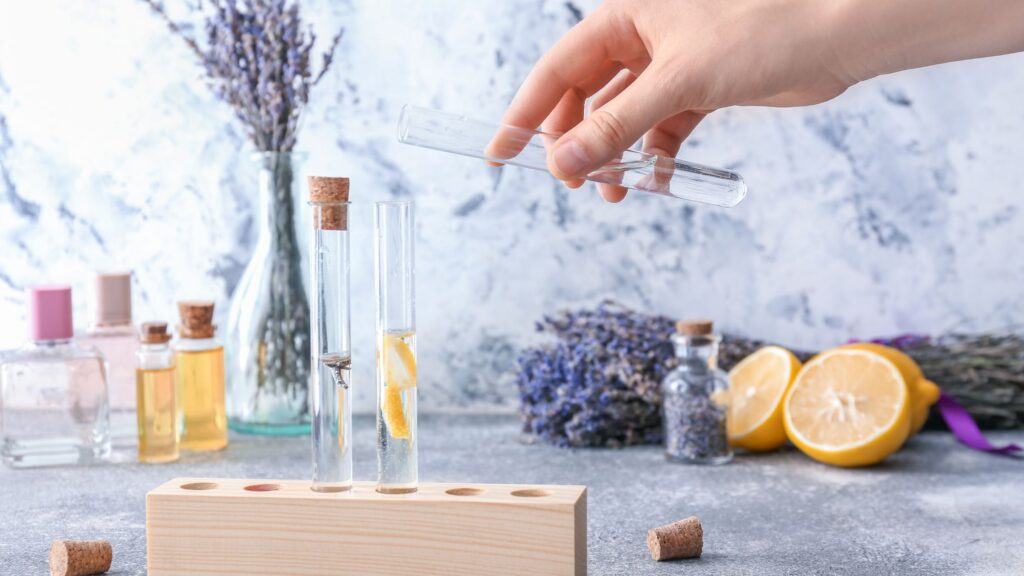
Blending the Scents Together
The third step to making your own perfume is blending the scents together. This is the fun and creative part where you can experiment with different combinations and proportions of essential oils and carrier oils.
There are no fixed rules to blending scents, but there are some general guidelines that can help you create a balanced and harmonious perfume. One of them is called the perfume pyramid.
The perfume pyramid is a way of classifying scents into three categories: top notes, middle notes, and base notes.
- Top notes are the scents that you smell first when you apply your perfume. They are usually light, fresh, and volatile, meaning they evaporate quickly. They give your perfume its initial impression and mood. Some examples of top notes are citrus, mint, and lavender.
- Middle notes are the scents that emerge after the top notes fade away. They are usually floral, fruity, or spicy, and they last longer than the top notes. They give your perfume its character and body. Some examples of middle notes are rose, jasmine, and cinnamon.
- Base notes are the scents that linger on your skin after the middle notes disappear. They are usually woody, earthy, or musky, and they last the longest of all. They give your perfume its depth and longevity. Some examples of base notes are sandalwood, vanilla, and musk.
To create a perfume pyramid, you need to choose one or more essential oils from each category and mix them together in a certain ratio. A common ratio is 30% top notes, 50% middle notes, and 20% base notes. For example, if you want to make a floral perfume, you can use:
- 3 drops of lemon (top note)
- 5 drops of rose (middle note)
- 2 drops of sandalwood (base note)
You can adjust the ratio according to your preferences or desired effects. You can also use more or less essential oils depending on how strong or subtle you want your perfume to be.
Once you have chosen your essential oils and their ratio, you need to blend them together in a small glass bottle. You can use an eye dropper or a pipette to measure and transfer the drops of essential oils. You can also label your bottle with the name and ingredients of your perfume.
After you have blended your essential oils together, you need to let them sit for at least 24 hours in a cool and dark place. This will allow the scents to mingle and mature, creating a more complex and refined fragrance.
Storing and Using Your Perfume
The final step to making your own perfume is storing and using it properly. This will ensure that your perfume lasts longer and smells better.
To store your perfume, you need to add some carrier oil to your essential oil blend. This will dilute your perfume and make it safe and gentle for your skin. You can use any carrier oil that you like, but make sure it has little or no scent of its own.
The amount of carrier oil that you need depends on how concentrated you want your perfume to be. A common concentration is 10%, which means 10 parts of essential oil blend to 90 parts of carrier oil. For example, if you have 10 ml of essential oil blend, you need to add 90 ml of carrier oil.
You can use a funnel to pour the carrier oil into your glass bottle with the essential oil blend. You can also use a measuring cup or a scale to measure the amount of carrier oil that you need.
After you have added the carrier oil to your perfume, you need to shake the bottle well to mix everything together. You also need to store your perfume in a cool and dark place away from heat and light sources. This will prevent your perfume from oxidizing or deteriorating over time.
To use your perfume, you need to apply it sparingly to your pulse points, such as your wrists, neck, behind your ears, or inside your elbows. These are areas where your blood vessels are close to the skin surface, which makes them warmer and more receptive to scents.
You can also apply your perfume to your hair or clothes for a longer-lasting effect. However, be careful not to stain your clothes.
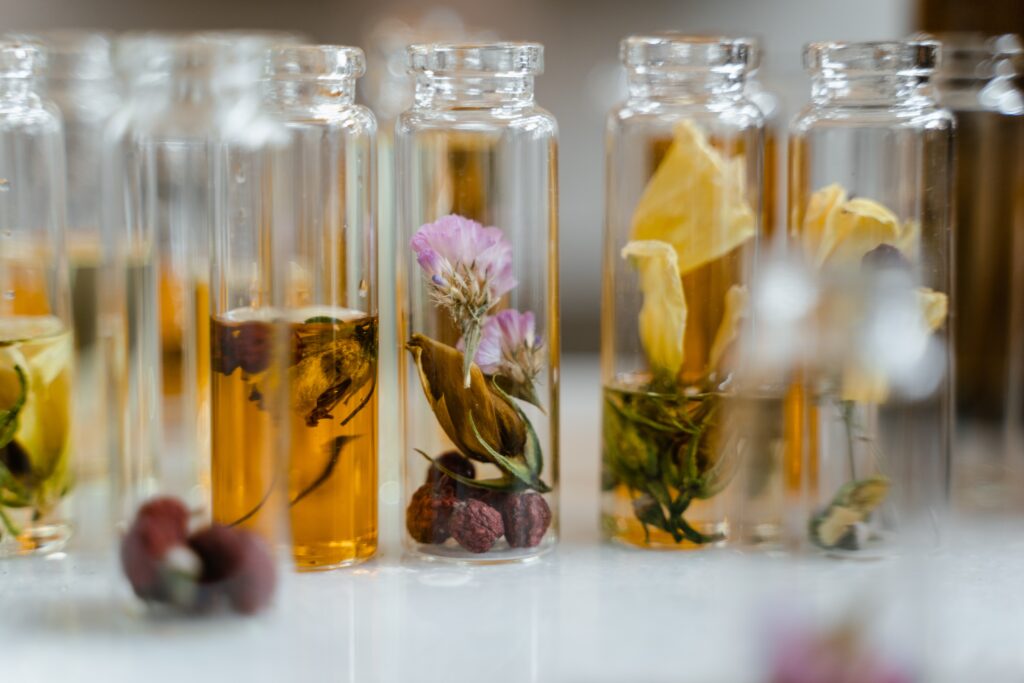
Benefits of Making Your Own Perfume
Making your own perfume has many benefits that you may not be aware of. Here are some of them:
Save Money
Making your own perfume is much cheaper than buying it from a store. You can use ingredients that you already have at home or buy them at a low cost. You can also make as much or as little as you want, depending on your needs and preferences. You don’t have to spend a fortune on expensive brands or fancy bottles.
Avoid Harmful Chemicals
Store-bought perfumes often contain harmful chemicals that can irritate your skin, cause allergies, or disrupt your hormones. Some of these chemicals are phthalates, parabens, synthetic fragrances, and artificial colors. Making your own perfume ensures that you are only using safe, natural ingredients that are good for your health and the environment.
Customize Your Fragrance
You can choose essential oils to create a perfume that is perfect for your personal preferences or desired mood. You can also experiment with different combinations and proportions of essential oils to create unique and original scents. You can make perfumes for different occasions, seasons, or purposes. You can also make perfumes for your friends and family as personalized gifts.
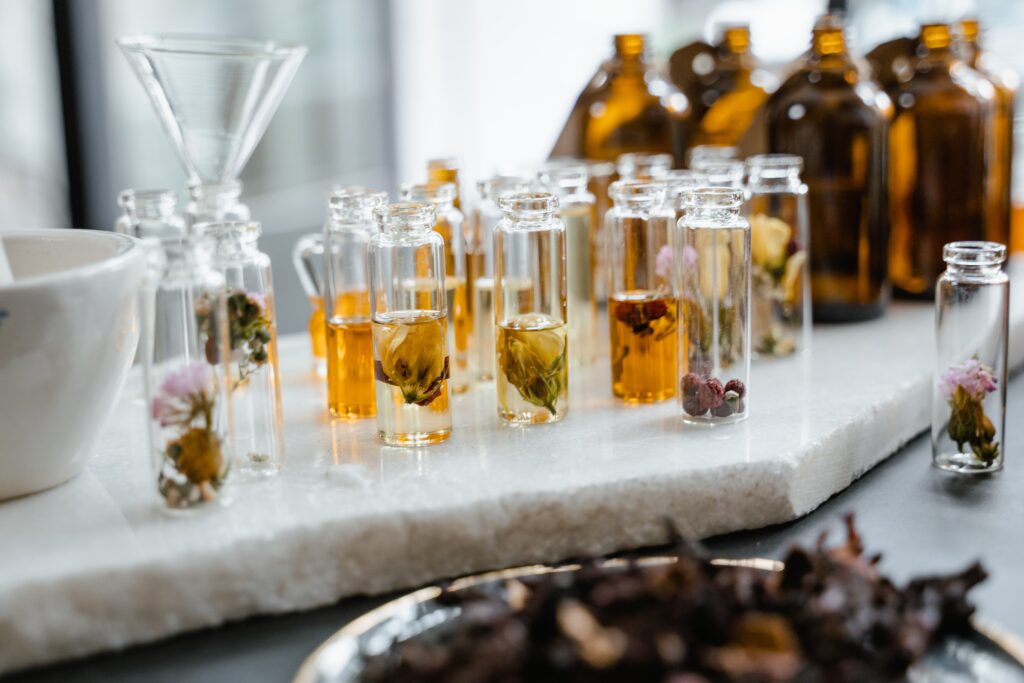
Enjoy the Therapeutic Effects of Aromatherapy
Aromatherapy is the use of scents to improve your physical and mental well-being. Different essential oils have different effects on your mood and emotions. For example, lavender can help you relax and sleep better, rose can uplift your mood and enhance your love life, and lemon can energize you and boost your immunity. By making your own perfume, you can enjoy the therapeutic effects of aromatherapy anytime and anywhere.
Conclusion
Making your own perfume at home is easy, fun, and rewarding. You only need two types of ingredients: essential oils and carrier oils. You can extract the scent from the ingredients using enfleurage, a simple and inexpensive method. You can blend the scents together using the perfume pyramid, a way of classifying scents into three categories: top notes, middle notes, and base notes. You can store and use your perfume properly by adding some carrier oil to your essential oil blend and applying it sparingly to your pulse points.
By making your own perfume, you can save money, avoid harmful chemicals, customize your fragrance, and enjoy the therapeutic effects of aromatherapy. So, what are you waiting for? Grab some ingredients and start making your own perfume today!
Thank you for reading and happy perfuming! 😊

